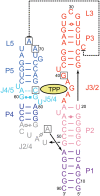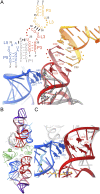Thermodynamic analysis of ligand binding and ligand binding-induced tertiary structure formation by the thiamine pyrophosphate riboswitch
- PMID: 19948769
- PMCID: PMC2802028
- DOI: 10.1261/rna.1847310
Thermodynamic analysis of ligand binding and ligand binding-induced tertiary structure formation by the thiamine pyrophosphate riboswitch
Abstract
The thi-box riboswitch regulates gene expression in response to the intracellular concentration of thiamine pyrophosphate (TPP) in archaea, bacteria, and eukarya. To complement previous biochemical, genetic, and structural studies of this phylogenetically widespread RNA domain, we have characterized its interaction with TPP by isothermal titration calorimetry. This shows that TPP binding is highly dependent on Mg(2+) concentration. The dissociation constant decreases from approximately 200 nM at 0.5 mM Mg(2+) concentration to approximately 9 nM at 2.5 mM Mg(2+) concentration. Binding is enthalpically driven, but the unfavorable entropy of binding decreases as Mg(2+) concentration rises, suggesting that divalent cations serve to pre-organize the RNA. Mutagenesis, biochemical analysis, and a new crystal structure of the riboswitch suggest that a critical element that participates in organizing the riboswitch structure is the tertiary interaction formed between the P3 and L5 regions. This tertiary contact is distant from the TPP binding site, but calorimetric analysis reveals that even subtle mutations in L5 can have readily detectable effects on TPP binding. The thermodynamic signatures of these mutations, namely decreased favorable enthalpy of binding and small effects on entropy of binding, are consistent with the P3-L5 association contributing allosterically to TPP-induced compaction of the RNA.
Figures





Similar articles
-
Structural basis for gene regulation by a thiamine pyrophosphate-sensing riboswitch.Nature. 2006 Jun 29;441(7097):1167-71. doi: 10.1038/nature04740. Epub 2006 May 21. Nature. 2006. PMID: 16728979 Free PMC article.
-
Probing riboswitch-ligand interactions using thiamine pyrophosphate analogues.Org Biomol Chem. 2012 Aug 14;10(30):5924-31. doi: 10.1039/c2ob07116a. Epub 2012 Apr 19. Org Biomol Chem. 2012. PMID: 22514012
-
Conformational Dynamics of thiM Riboswitch To Understand the Gene Regulation Mechanism Using Markov State Modeling and the Residual Fluctuation Network Approach.J Chem Inf Model. 2018 Aug 27;58(8):1638-1651. doi: 10.1021/acs.jcim.8b00155. Epub 2018 Jul 27. J Chem Inf Model. 2018. PMID: 29939019
-
Exploring the structure, function of thiamine pyrophosphate riboswitch, and designing small molecules for antibacterial activity.Wiley Interdiscip Rev RNA. 2023 Jul-Aug;14(4):e1774. doi: 10.1002/wrna.1774. Epub 2023 Jan 2. Wiley Interdiscip Rev RNA. 2023. PMID: 36594112 Review.
-
Structural studies of the purine and SAM binding riboswitches.Cold Spring Harb Symp Quant Biol. 2006;71:259-68. doi: 10.1101/sqb.2006.71.015. Cold Spring Harb Symp Quant Biol. 2006. PMID: 17381305 Review.
Cited by
-
Imaging metabolite dynamics in living cells using a Spinach-based riboswitch.Proc Natl Acad Sci U S A. 2015 May 26;112(21):E2756-65. doi: 10.1073/pnas.1504354112. Epub 2015 May 11. Proc Natl Acad Sci U S A. 2015. PMID: 25964329 Free PMC article.
-
Naturally occurring three-way junctions can be repurposed as genetically encoded RNA-based sensors.Cell Chem Biol. 2021 Nov 18;28(11):1569-1580.e4. doi: 10.1016/j.chembiol.2021.04.022. Epub 2021 May 18. Cell Chem Biol. 2021. PMID: 34010626 Free PMC article.
-
Modulation of quaternary structure and enhancement of ligand binding by the K-turn of tandem glycine riboswitches.RNA. 2013 Feb;19(2):167-76. doi: 10.1261/rna.036269.112. Epub 2012 Dec 17. RNA. 2013. PMID: 23249744 Free PMC article.
-
RNA-Ligand Interactions Quantified by Surface Plasmon Resonance with Reference Subtraction.Biochemistry. 2022 Aug 2;61(15):1625-1632. doi: 10.1021/acs.biochem.2c00177. Epub 2022 Jul 8. Biochemistry. 2022. PMID: 35802500 Free PMC article.
-
Staphylococcus aureus CidC Is a Pyruvate:Menaquinone Oxidoreductase.Biochemistry. 2017 Sep 12;56(36):4819-4829. doi: 10.1021/acs.biochem.7b00570. Epub 2017 Aug 25. Biochemistry. 2017. PMID: 28809546 Free PMC article.
References
-
- Alam S, Grum-Tokars V, Krucinska J, Kundracik ML, Wedekind JE. Conformational heterogeneity at position U37 of an all-RNA hairpin ribozyme with implications for metal binding and the catalytic structure of the S-turn. Biochemistry. 2005;44:14396–14408. - PubMed
-
- Batey RT, Gilbert SD, Montange RK. Structure of a natural guanine-responsive riboswitch complexed with the metabolite hypoxanthine. Nature. 2004;432:411–415. - PubMed
-
- Brünger AT, Adams PD, Clore GM, Gros P, Grosse-Kunstleve RW, Jiang J-S, Kuszewski J, Nilges M, Pannu NS, Read RJ, et al. Crystallography and NMR system: A new software system for macromolecular structure determination. Acta Crystallogr D Biol Crystallogr. 1998;54:905–921. - PubMed
-
- Canny MD, Jucker FM, Kellogg E, Khvorova A, Jayasena SD, Pardi A. Fast cleavage kinetics of a natural hammerhead ribozyme. J Am Chem Soc. 2004;126:10848–10849. - PubMed
Publication types
MeSH terms
Substances
Grants and funding
LinkOut - more resources
Full Text Sources
Other Literature Sources
Molecular Biology Databases
